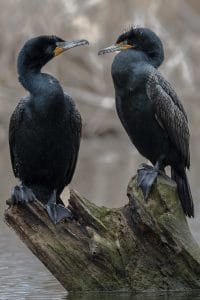On November 19th 2018, ERO # 013-4124 was posted by the Ontario Ministry of Natural Resources (MNRF) on the Environmental Registry of Ontario, titled “Proposal to establish a hunting season for double-crested cormorants in Ontario”.
Chances are you have not seen this already, as it is not getting a lot of media coverage, and the small way in which it has been presented for public scrutiny by its authors is questionable, as is the timing and the limited time frame (45 days) to reply to the government about it. We encourage all who see this for the incredibly ridiculous idea that it is, to respond vigorously against it through the method provided you by MNRF, and to do so immediately since on January 3rd 2019 the door on the issue will be closed to you.
To give an idea of some of the things this proposal is offering, and many of the points that sensible, intelligent, and compassionate humans are arguing against it, please continue reading below.
Proposed legislation would:
• designate double-crested cormorants as a “game” bird species,
• create a province wide annual hunting season from March 15 until December 31,
• allow anyone holding a valid Ontario Outdoors Card and small game hunting license to kill up to 50 cormorants per day (1,500 per month or more than 14,000 per season) and,
Key arguments against include:
• hunt would cause unimaginable cruelty by allowing the wholesale, uncontrolled, impossible to monitor, slaughter of cormorants across the province,
• devastate and possibly eradicate a recovered native wildlife species,
• result in disturbance, destruction and death of numerous federally protected non-target bird species such as Great Blue Herons, Great Egrets and White Pelicans,
• potentially damage natural ecosystems
• encourage the worst form of “slob hunting”
• endanger and disturb the public by allowing hunters to discharge firearms throughout the spring, summer and fall season when lakes and natural areas are populated by cottagers and tourist
• this needlessly demonizes wildlife at a time when the planet is experiencing the loss of species unprecedented in human history
• There is no substantive body of evidence proving that cormorants are depleting fish stocks or causing any ecological problems whatsoever
• it is broadly acknowledged that the presence of cormorants indicates a healthy fishery
• Cormorants being fish-eating birds are not ecologically able to deplete their own food supply,
• Small congregations could be wiped out in just a few minutes or an hour, while larger colonies could be destroyed in just a few days or a week. Years of effort and thousands of dollars to recover the species will have been for nothing.
• these birds nest in colonies, so it would be quite easy for a hunter to go up to a colony where they’re nesting and easily take out an entire colony in a single day
• Common terns and great blue herons can also nest in the same areas, so they can also have their breeding affected by this disruption. If entire colonies are eradicated, it’s unclear how this would affect an area’s ecosystem.
• Although it’s true that cormorants can cause damage to properties, the law already allows property owners to deal with this problem. Under the Fish and Wildlife Conservation Act, property owners may harass, capture or kill wildlife that is causing or is about to cause damage to their property.
• DDT use dramatically decreased cormorant populations in the 1960s. When DDT was banned, they made a comeback. The recent rise in cormorant numbers is the result of a recovery from a previously precarious position. In fact, it appears that cormorant populations have plateaued in recent years. Yet, many people still think they are over-abundant
• humans deciding they are going to manipulate nature almost always ends up making things worse
• Non-human lives matter outside of measurable value to humans.
• The current law already addresses extenuating circumstances with cormorant populations. Culls have taken place to protect sensitive areas and heritage sites. This case-by-case approach is much safer than lifting protection entirely. It allows us to be sure that intervention is justified before we take action.
You can comment to the EBR either registered or anonymously or write directly to the MNRF with “EBR 013-4124 Cormorant” in the subject line at: wildlifepolicy@ontario.ca
Tim Dyson and Drew Monkman
